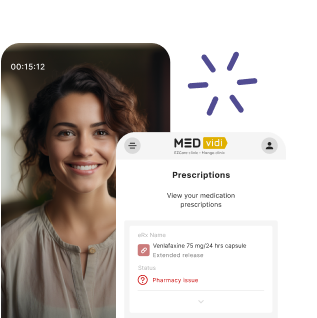Highlights
- Guanfacine is a non-stimulant medication used off-label for adults with ADHD.
- It is prescribed alone or as an adjunctive treatment for ADHD when stimulant medications or other treatments are unsuitable or ineffective.
- Intuniv affects the prefrontal cortex, which lowers blood pressure and controls impulsivity and attention span.
- Guanfacine may cause side effects, such as lightheadedness, drowsiness, dizziness, fainting, or decreased alertness.
- Guanfacine may interact with other medications, including over-the-counter, prescription, and vitamin supplements.
A combination of behavioral therapy and stimulant medications is frequently used to treat attention deficit hyperactivity disorder (ADHD). But occasionally, medical professionals recommend non-stimulant medicines such as Intuniv (guanfacine).
Intuniv can be used to treat ADHD along with stimulants; however, people who do not benefit from stimulants or cannot tolerate them can use guanfacine alone as a monotherapy. Read on to learn about the pros and cons of taking Intuniv, its side effects, and other features.
Consult with an ADHD expert

What Is Intuniv (Guanfacine)?
Guanfacine medication is
Intuniv is a type of medication that acts on
When Is Guanfacine Used for ADHD?
Guanfacine is a second-line treatment for ADHD. It is prescribed when stimulant medications (the first-line ADHD treatment) are not suitable or ineffective for the patient. Guanfacine extended-release tablets can be used alone or with other medications to increase efficacy.
How Does Intuniv Help With ADHD?
It was first approved for treating ADHD in adults in Japan in
Unlike stimulants like Adderall, Intuniv has a different effect on the brain. It acts on the prefrontal cortex, a brain area that regulates attention span and impulsivity and decreases blood pressure. It also treats the other symptoms of ADHD, including social aggression, hyperarousal, emotional sensitivity, and rejection sensitivity. By decreasing adrenaline levels to normal, it helps manage the issues that stimulants do not adequately treat.
Intuniv Dosage
The dosage of this medication varies depending on the patient. Usually, it starts with 1 mg daily and slowly increases to 3 mg if needed. The recommended dose is usually not more than 4-5 mg. These are only the typical dosages, so do not alter your dose if it differs from the one recommended by your doctor.
A Missed Dose: What to Do
If you forget to take the medication, it’s advisable to take it as soon as possible. However, you may skip the dose if you are close to the time for your next dose and continue your routine dosage. Avoid doubling the dose to catch up. To be sure, it’s best to consult your doctor.
Storage and Disposal
Store Intuniv at room temperature, away from moisture and light. It is also essential to keep it out of the reach of children and pets. It is generally advised to properly dispose of unwanted or expired medications using a drug take-back program or bringing them to a pharmacy. Follow any other particular directions given by your pharmacist or healthcare practitioner regarding disposal.
Intuniv Side Effects
Intuniv may cause adverse reactions. The most typical ones are the following:
- Drowsiness
- Dizziness
- Fatigue
- Dry mouth
- Constipation
- Irritability
- Nausea
- Weight gain
- Headache
Other serious side effects include the following:
- Extreme dizziness
- Slow heartbeat
- Changes in mood (depression, suicidal thoughts, or hallucinations)
- Fainting
Effects of Intuniv on Cardiovascular System
Although guanfacine is primarily used to treat high blood pressure and ADHD, it can cause changes in blood pressure and heart rate while starting or when adjusting the dosage. So, it’s important to notice any concerning symptoms or changes, such as chest pain, irregular heartbeat, or severe dizziness, to ensure the safe and effective use of Intuniv.
Guanfacine Interactions
Inform your doctor about all your medications, including prescription drugs, over-the-counter medicines, vitamins, and supplements, because guanfacine may have possible drug interactions. Below are some of the medications that can interact with and reduce the benefits of Intuniv:
- Antihypertensive Agents: Intuniv may raise the risk of hypotension (low blood pressure) when taken with other blood pressure-lowering medications.
- Central Nervous System Depressants: Guanfacine’s sedative effects may be enhanced by other medications and substances that also have a sedative effect, such as alcohol, opioids, or benzodiazepines.
- CYP3A4 inhibitors: Protease inhibitors, antibiotics, and antifungals can raise the body’s levels of guanfacine, which may have
adverse effects [4*] . - Antihypertensive Agents: Intuniv may raise the risk of hypotension when taken with other blood pressure-lowering drugs.
- Tricyclic Antidepressants (TCAs): Intuniv used in conjunction with TCAs may cause low blood pressure.
Other Risks and Warnings
Although guanfacine treatment is generally well tolerated, there are certain risks associated with using it. Important warnings about Intuniv include the following:
- Blood pressure may drop, particularly when standing up after sitting or lying down. It can cause dizziness or fainting, especially at the beginning of the treatment of ADHD or when the dosage is increased.
- Those who already have heart problems or are taking other medications that alter heart rate may find it problematic when Intuniv slows down their heart rate.
- Intuniv may make you feel sleepy or drowsy, making it harder to perform mentally demanding activities like driving or operating heavy machinery.
- In certain people, it may worsen
depression [5*] or other mental health issues. Particularly for people with a history of mental illnesses, close observation is required.
Guanfacine Withdrawal Symptoms
Intuniv (guanfacine) withdrawal symptoms can include tremors, agitation, anxiety, and headaches. When stopping the medication abruptly, your blood pressure may also rise quickly. If you experience such effects or other severe withdrawal symptoms, get in touch with your doctor immediately.
Precautions for Use
Not everyone can take Intuniv, and only a healthcare professional can choose the most appropriate medication. Some precautions are the following:
- If you have ever experienced an unusual or allergic reaction to this medication or any other medications, or if you have any other allergies, let your doctor know.
- Tell your doctor if you are taking any additional medications to avoid dangerous interactions. Abametapir, Fedratinib, Netupitant, and Fosetupitant are medications that may interact with Intuniv.
- Additional health issues could impact the use of this medication. Tell your doctor if you have any other medical problems.
- Only use this medication as prescribed by your doctor. Never take it in larger amounts, more frequently, or for a longer period of time than recommended by your healthcare provider.
- Inform your doctor if you are a breastfeeding mother or expecting a child.
Summing Up: Is Intuniv the Best Medication to Treat ADHD in Adults?
There are many ADHD medications, with stimulants usually being a first-line choice. For example, amphetamine/dextroamphetamine (Adderall), methylphenidate (Ritalin), lisdexamfetamine (Vyvanse), dexamfetamine (Dexedrine), and atomoxetine (Strattera). However, non-stimulants like Intuniv can also be prescribed when prior treatment is not as effective as expected.
Reach out to medical professionals at MEDvidi if you notice symptoms of ADHD and want to receive personalized treatment.
Frequently Asked Questions
How does guanfacine make you feel?
Effects of Intuniv can vary from person to person. However, it is often reported to improve focus and reduce impulsivity.
How long does it take guanfacine to work for ADHD?
Does guanfacine increase focus?
How effective is guanfacine for ADHD?
What are the positive effects of guanfacine?
Intuniv helps people with ADHD by enhancing attention, lowering impulsivity, and improving behavior regulation.















